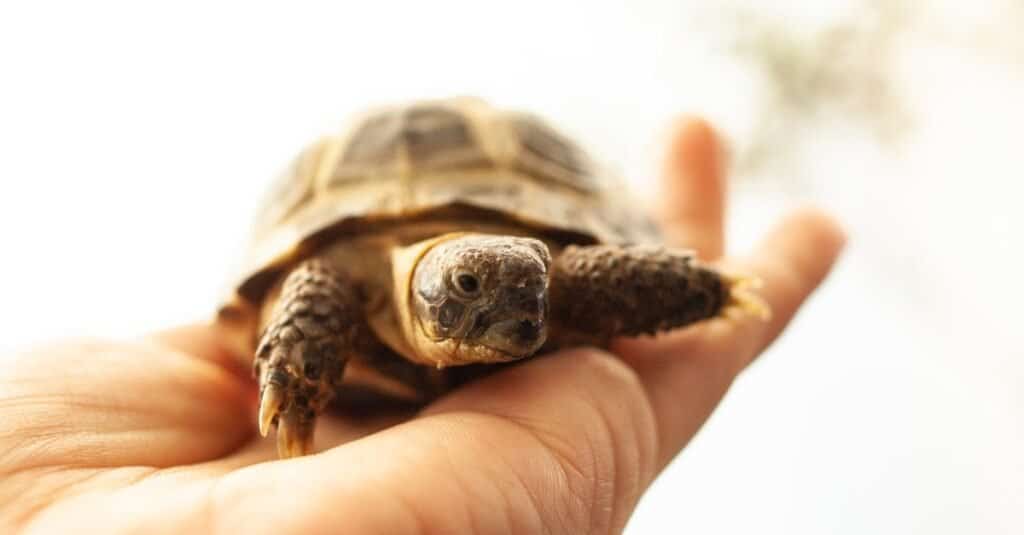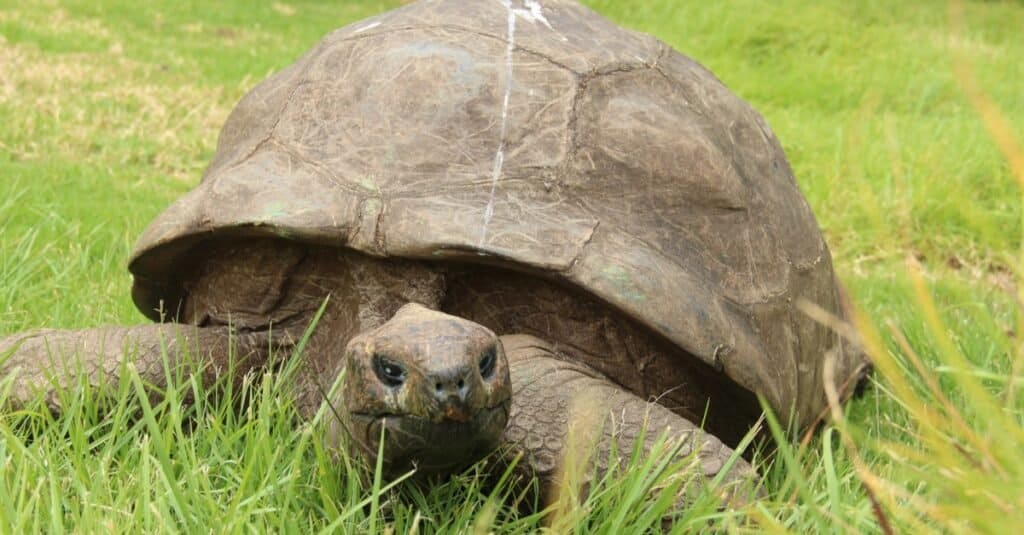Tortoises are one of the longest-living animals on land, sometimes living more than 200 years. These magnificent animals frequently outlive their human caretakers and are known for their slow and steady approach to life.
The Russian tortoise lifespan is over 40-50 years when they are well-cared for. They can surpass this age by a lot, sometimes living to be up to 100 years old.
In this article, you’ll learn all about the Russian tortoise lifespan—from how long they live to their top causes of death and how they compare to other tortoise species.
How Long do Russian Tortoises Live?

The Russian tortoise (Agrionemys horsfieldii) in the Kyzylkum Desert, Uzbekistan, Central Asia.
©Kirill Skorobogatko/Shutterstock.com
Russian tortoises live to be over 40-50 years old on average. They can live as long as 100 years!
As pets, they’re certainly a lifetime commitment—you might even consider who will adopt your tortoise when you pass away, as they’re likely to outlive you!
We don’t know the average age of wild Russian tortoises, though they’re likely to live less time than pet tortoises due to their increased risk from predators, poor outdoor conditions, and other disasters.
Why Do Russian Tortoises Live so Long?

Russian tortoise having a walk outdoors in the garden.
©Elena M. Tarasova/Shutterstock.com
It’s thought that tortoises live longer than many other species due to their slow metabolisms. Animals who are less active with slower metabolisms tend to live longer than those who are very active with fast metabolisms. One example is the Greenland shark which is a slow metabolism shark that can live for perhaps 500 years. In the wild, Russian tortoises can hibernate for up to 9 months a year during winters. In captivity, they’ll generally hibernate for much shorter periods (between 2 and 5 months).
Their long lives might also come down to their genes, which can repair DNA, aid their immune response, and suppress cancer.
Russian Tortoise Development and Life Cycle

Russian Tortoise baby on a person’s hand.
©KOTORICHIKAPHOTO/Shutterstock.com
Russian tortoises are about one inch long when they first hatch from eggs. They continue to grow until they are 8-10 inches long. It takes a Russian tortoise anywhere from 15 to 20 years to reach their full adult size.
Female tortoises will begin to lay eggs once they are about 6 inches long, and may lay up to five eggs at once.
What are the Most Common Causes of Russian Tortoise Death?
Improper Care
Before adopting a Russian tortoise, it’s vital to understand how to care for them. They need the proper diet, enclosure, and maintenance.
Feeding your tortoise a bad diet, keeping them outdoors in cold weather, or failing to clean their enclosure for long periods can all lead to illness or death.
Stress is also a leading cause of death for tortoises, so make sure they feel at home in their space by researching their care needs ahead of time!
Health Conditions
Russian tortoises may suffer from the following health conditions:
- Respiratory Infections. This is most common in wild or wild-caught tortoises, but can happen to any Russian Tortoise.
- Soft shell. This can occur due to nutritional deficiencies caused by diet, lack of sunlight, or birth defects.
- Prolapse. This is when a turtle strains trying to use the bathroom, and pushes out their organs instead. It’s caused by improper diet and dehydration.
Bring your pet tortoise to the veterinarian immediately if they are showing signs of illness.
Injuries
Handling your tortoise too roughly or exposing them to dangers such as predators can cause injuries such as shell damage, which can be deadly if not treated.
If your tortoise is injured, bring them to the veterinarian as soon as possible for treatment.
Drowning
Tortoises cannot swim, and should never be put in water that covers their face.
Some people don’t know this, and it leads to tortoises drowning—often due to good intentions on the humans’ part!
Natural Disasters
Wild Russian Tortoises are more likely to die in natural disasters than captive tortoises. This includes storms, wild fires, flooding, and severe cold.
Russian Tortoises cannot withstand freezing temperatures.
Predators
Of course, the leading cause of death in wild Russian Tortoises is predators. These animals might also get ahold of a pet tortoise who isn’t enclosed properly.
In the wild, predators of Russian Tortoises include snakes, lizards, birds of prey, coyotes, opossums, raccoons, skunks, and foxes.
Tortoises unfortunately have predators in your backyard, including other common pets like cats and dogs.
Baby tortoises are most likely to be killed, but any tortoise is vulnerable if they are left outdoors without a secure enclosure. If a domestic tortoise is released into the wild, it will mostly likely die too. They are creatures of habit who have difficulty adapting to new environments.
How does the Russian Tortoise Lifespan Compare to Other Tortoises?

Jonathan, a Seychelles giant tortoise, and possibly the oldest animal alive, on the grounds of Plantation House on St Helena.
©Snapper Nick/Shutterstock.com
Some tortoises are known to live over 150 or even 200 years. While the Russian Tortoise isn’t one of the longest-living tortoises, they do live a long time—potentially past their 100th birthday!
The oldest known living tortoise is Jonathan, a Seychelles giant tortoise that is 189 years old as of 2021. He was born in 1832 and lives on the island of Saint Helena.
It’s estimated that the longest-living tortoise in the world was over 250 years old. However, this tortoise was not a Russian Tortoise, but an Aldabra giant tortoise. Other reports of tortoises have them reaching up to 344 years of age, but these reports are disputed.
Regardless, tortoises can reach ages that are significantly beyond any other land animal!
Up Next…
Turtles and tortoises…similar but not the same! Discover more about your favorite creatures who carry their homes on their backs.
- Are Turtles Mammals? What exactly IS a turtle?
- What Do Tortoises Eat? 20+ Foods That They Eat If you’re bringing home a pet turtle, you definitely need to prepare a food stash!
- Tortoise vs Turtle: 10 Biggest Differences Explained Click here to discover the differences between turtles and tortoises.
The photo featured at the top of this post is © Susan Schmitz/Shutterstock.com
Thank you for reading! Have some feedback for us? Contact the AZ Animals editorial team.






